The Split: A Blessing in Disguise
The 1989 split between Urantia Foundation and Urantia Brotherhood, once regarded as a catastrophe, can now be viewed as necessary for the growth of the Urantia movement.
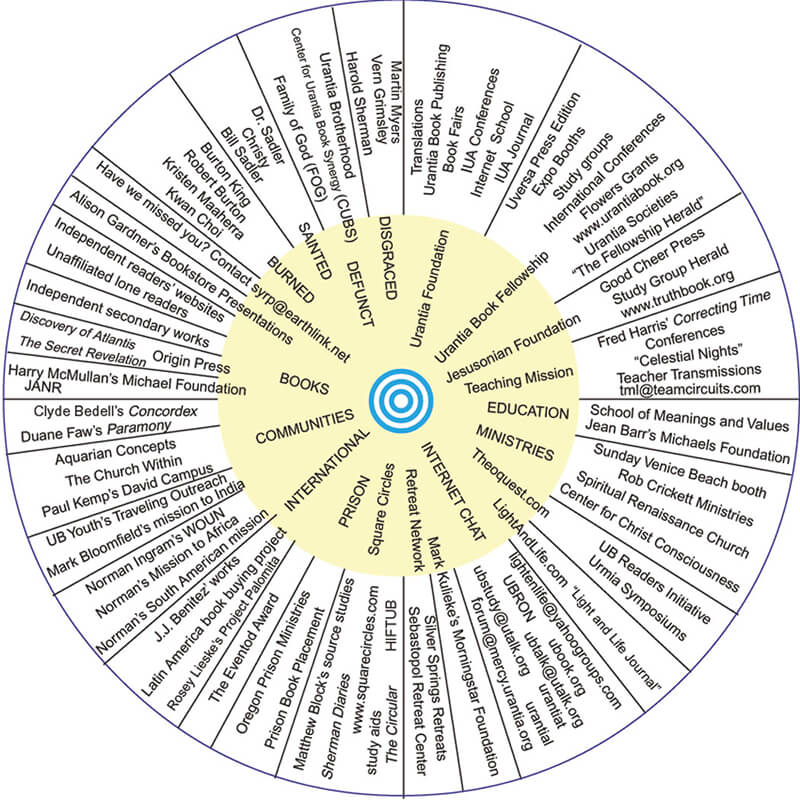
by Saskia Raevouri (2003)
WHEN I first found the Urantia Book in 1977 and began reading it on my own, I loved the idea that I could “be religious” and worship God without having to join an organization. It was just me and God and the good deeds we could do together. I pictured the “true church” as being made up of billions of such diverse individuals, all dominated by one will—God’s will. This was the ultimate freedom of religion, and it felt right.
I can still remember the shock when, after buying my own copy of the book (I had been reading my brother’s), a leaflet fell out promoting the Urantia Brotherhood with a capital B. Wasn’t the “brotherhood of believers” in our hearts, with a lowercase b? Who were these people who were organizing this Brotherhood? And why? It went against my grain and troubled me a lot.
But I hungered to meet other readers, and in those pre-Internet days the only way I could find them was by writing a letter to the Chicago address in the front of the book. I received a reply from Emma Christensen, who had been around since the beginning, putting me in touch with Julia Fenderson, who led a group of readers in the Los Angeles area [read Julia's letter]. They were all members of the First Urantia Society of Los Angeles, the local chapter of the Brotherhood, and they met monthly. I was assured that the group was more like a book club than a church or a new religion, that there were no rituals or traditions, and that joining would put me on the mailing list and keep me in touch with these wonderful people. I became a member even though I had never joined anything before in my life.
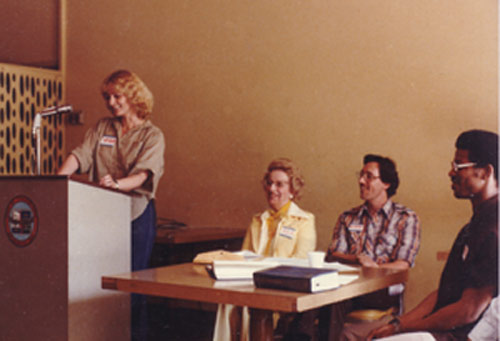
Julia Fenderson, Kermit Anderson, and Gregory Weydevu (who joined on the same day).
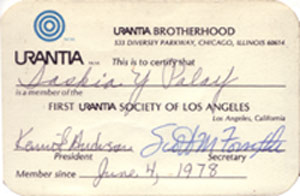
For about a year I attended local study groups, did volunteer work on the Agondonter newsletter, and received mail from “headquarters” in Chicago, treasuring every pamphlet and piece of paper as holy writ. I visited Julia often and learned about Dr. Sadler and the origins of the Book, a subject that endlessly fascinated me. I found out that there were two separate organizations, the Foundation to publish the book and the Brotherhood as the social arm. To me, it sounded like one big, happy organization with no dividing line. I’d had reservations beforehand, but once a member I felt quite happy to be part of such a select group of individuals, more so after discovering how rare it was for someone to accept the revelation. It made sense that there would need to be a “clearinghouse” to put readers in touch with one another to form study groups, to organize conferences and encourage the formation of teams for spreading the good news.
Then, one day around 1979, something terrible happened. I opened a fat envelope announcing the severance of a Urantia group in Houston, Texas, from the people in Chicago. [Read correspondence related to the Houston affair here and here] The tone was unspiritual. I was shattered. Was there trouble in Paradise? If a serious problem existed, why couldn’t it have been worked out in such a way that it set an example of how those in possession of higher knowledge dealt with friction and disharmony? Why did they have to "go to law" against each other?
Everyone I questioned about it talked a party line. I couldn’t understand what the Texas people had done to be expelled, and I was left feeling embarrassed for "headquarters." To preach the gospel but not act it out was a mockery. Right then I wanted to un-join, but at the same time I needed to stay connected to my new soulmates. While my enthusiasm for the Urantia Book itself knew no bounds, I lost interest in attending official meetings. Whenever I bought someone a Urantia Book I would first remove and discard the leaflet inviting the potential new reader to join the “tainted” Brotherhood.
Another thing that bothered me was a budding traditionalism at Urantia gatherings. Jesus had declared that he was reducing all rituals down to one—a supper to be held in memory of him. To me, this meant we should all gather for a big, festive meal, brought together by our common understanding of higher universe laws. Instead, at the Los Angeles gatherings for the August 21 Jesus’ birthday celebration, a goblet was passed around and the holder was expected to say something inspirational about Jesus. The first time it seemed like a nice thing to do and I went along with it, but when this happened for the second and third time, following certain rules that someone had established, alarm bells rang inside me. This was a cultlike ritual, and if someone didn’t put a stop to it, or do something to make it different each time, it would become associated with the Book and scare away honest seekers who might be offended by it. My reaction was to boycott all gatherings where the goblet was to be passed. Few openly agreed with my stance, or were able to see the future negative repercussions of what, to them, was a beautiful tribute to Jesus.
Notwithstanding the Master's effort thus to establish this new sacrament of the remembrance, those who followed after him in the intervening centuries saw to it that his express desire was effectively thwarted in that his simple spiritual symbolism of that last night in the flesh has been reduced to precise interpretations and subjected to the almost mathematical precision of a set formula. Of all Jesus' teachings none have become more tradition-standardized.[1492]
For the next sixteen years my involvement with the movement was relatively low-key. I married a reader named Andy Raevouri who, it later turned out, had only been briefly and superficially interested in the Jesus papers. I heard through the grapevine about other lawsuits and about the disgrace and downfall of the cult of Vern Bennom Grimsley, and I was vaguely aware of the 1989 “split” between the Urantia Foundation and the Urantia Brotherhood. I became so disenchanted that I even stopped opening their mail.
***
In 1983 I had created a study aid called “The Evolution of Life on Earth,” which depicted my concept of how all life on our planet was interrelated. [Click here to see it.] While crude, it was helpful and quite popular. I printed up five hundred copies and managed to distribute most of them over the years.
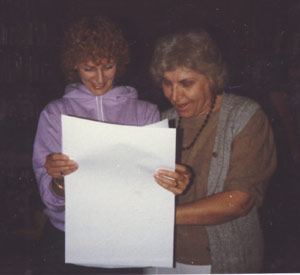
I had practically forgotten about it when around 1994 it received a revival of sorts by being offered through the now-defunct Good Cheer Press catalog, produced by the Jesusonian Foundation. This triggered a series of events that brought me back into the movement. I joined a local study group and made some new friends, including Paula Thompson of Jesusonian. Early in 1997 I contacted Urantia Foundation to buy a copy of the French translation of the UB, and during my conversation with Foundation representative Bob Solone it came up that I was the creator of the Evolution Chart, for which the Foundation had had requests. Bob told me how much he liked it and that the Foundation had been trying to locate me, that they were interested in publishing and distributing it. I was flattered and made arrangements to spend a week in Chicago, combining the revision of my chart with volunteer work at the legendary 533 Diversey Parkway.
Around the same time I received an invitation for the fortieth anniversary reunion party of the First Urantia Society of Los Angeles, of which I was apparently still a member although I hadn’t paid dues for many years. It was to take place June 24, 1997, at the Renaissance Hotel near the Los Angeles airport. Thinking it would be fun to see all those old faces again, I decided to attend what turned out to be a milestone event in my life. Here is where I met my future partner, Matthew Block. Matthew was working for the Fellowship (formerly the Brotherhood) in Chicago and was present in an official capacity.
At this event I was shocked by the reaction I received when I mentioned that I’d soon be going to Chicago to visit the folks at 533. I’d had no idea how bitter the split was—had barely known the difference between the Foundation and the Brotherhood/Fellowship. The last time I had seen former FUSLA president Scott Forsythe was in the late ’70s, as he was leaving Los Angeles to work at headquarters in Chicago. “How are things at the Foundation?” I asked innocently. Scott looked at me as if I had marbles in my head. I made a few similar faux pas before realizing that I had stumbled into a war zone and had better watch my words. The deep-seated animosity between the two camps could only spell disaster for our revelation, and I knew I had to get involved, to do something to try to heal this wound.
I also began to wonder if it was wise to let the Foundation take over my Evolution Chart, which merely represented one person’s simplified version of a complex subject. Matthew Block had pointed out some flaws in the chart. I saw that no matter how much it was corrected and polished up, it would never be good enough to carry the three-concentric-circles logo. And worse, innocent readers might be misled into believing it to be an official interpretation, which would stifle their own creative attempts to visualize the subject. The Foundation, it became clear to me, was to deal strictly with the primary work—the unadulterated and inviolate text of the Urantia Book and its translations—and should leave secondary and derivative works to others. I wrote them a letter saying so [click here to read it]. However, as I had already booked air and hotel, I told them I was coming to Chicago to visit anyway, to meet them and do whatever volunteer work they had for me.
Blissfully ignorant of the real factors that led to the split and who was “good” or “bad,” I spent a wonderful week in Chicago, staying at the nearby Surf Hotel. Every day I would go in to 533, where I met and fell in love with Executive Director Tonia Baney and her husband Steve, Australian volunteers Trevor and Kathleen Swadling, Foundation staff Bob Solone and Damian and Joan Bondi, and two visitors—California reader Jane Ploetz and Finnish translator Seppo Kanerva. Tonia assigned me the task of double-checking the UB quotes which the submitters of secondary works had used in their books, setting me up in a back room with a computer. Every day as we worked and ate together, we discussed the spiritual and political aspects of the revelation and had a great time laughing and getting to know each other.
Having already been exposed to the Fellowship’s feelings about the split, I now got the Foundation’s angle. Just weeks ago, they told me, a court had reversed an earlier decision that had placed the book in the public domain, and the Foundation now had the copyright back. The atmosphere at 533 was one of jubilation and confidence.
I also learned that the Foundation, after the split, had created its own new social organization—the International Urantia Association (IUA)—to carry the trademarked logo and the name “Urantia,” and to disseminate the teachings in “an orderly fashion,” as a substitute for the disenfranchised Brotherhood. The Foundation, it seemed, now had everything: a book publishing monopoly and an official membership organization pledged to support its policies and procedures. The Fellowship, by contrast, was left with its current members and supporters, but with little chance for growth. Most potential members appeared only after contacting the address in the front of the book. Since the Foundation listed only the name of its own organization and no longer shared new readers’ names with the Fellowship, the Fellowship’s life support had been cut off and it was now just a matter of time before it passed into history. What troubled me most about this was that the IUA, like the Brotherhood before it, had been artificially created by a tiny group of people to be the "authentic" organization, representing a revelation meant for the entire world. With enough support, it could grow into a large but exclusive religious organization like the Catholic Church.
There were many issues that I didn’t agree with the Foundation on, and I told them so. For instance, I understood the mandate in the Declaration of Trust, to preserve the text inviolate, as applying only to the Foundation and not to other groups or individuals. The Foundation’s mission, I believed, was to continue to publish the complete book, even if others split it up. If the trustees could see it my way, it would relieve them of their “duty” to go around policing what the rest of the readership was doing with the revelation, and still be faithful to their trust.
Another matter that I couldn’t comprehend was the Foundation’s ownership of the concentric circles logo. If this was the cause of so much strife, why couldn’t the trustees release it to the world and adopt another symbol for the work they were doing? It’s true that Melchizedek wore this emblem on his breastplate to represent himself in a barbaric world, but Jesus did not identify himself with the circles; he came to wean us away from such material icons and fetishes. Not surprisingly, nobody took my suggestion seriously. (At that time I thought it would be a good idea to use the concentric-circles symbol to signify the full and unadulterated text, for all publishers of the revelation, like the Good Housekeeping Seal of Approval, but I have since changed my mind. That would be a recipe for more litigation, as those who believe this symbol should be free for all would rebel and taunt the Foundation by using it to provoke another lawsuit.)
On Tuesday evening, a study group was held in the room on the second floor of 533 where the historic Forum meetings had taken place. I came away from my visit satisfied that, although we didn’t see eye to eye on very much, all involved were sincere believers in and workers for the revelation.
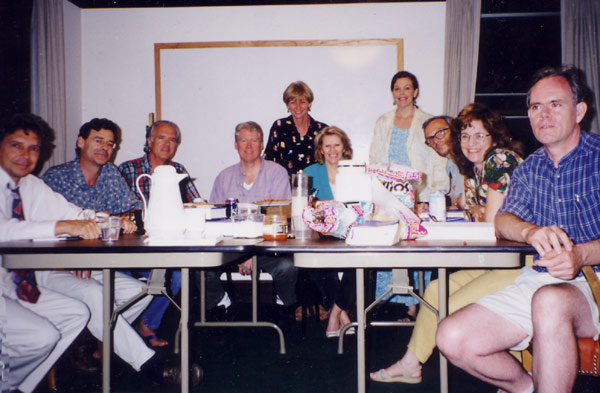
Steve Baney, ?, Saskia Raevouri, Tonia Baney, Kathleen Swadling, ?, Jane Ploetz, ?.
* * *
Back home in Los Angeles, I reconnected with the local Urantia community by attending a weekly study group at the home of Hal and Lucille Kettell, in Arcadia. In addition, the Kettells hosted monthly Teaching Mission sessions—a Sunday potluck followed by transmissions from teachers. [Read about the history of the TeaM here.] The TeaM sessions were wonderful social occasions and I grew to love these brothers and sisters as sincere religionists devoted to doing God’s will and spreading the benign virus of love. Few seemed politically inclined and most were content within their own group. And the substance of the transmissions was perfectly in line with the teachings of Jesus.
I also began hearing about other groups that were associating themselves with the name Urantia. My UB friend Polly Friedman told me about a cult of readers in Sedona—the Aquarian Concepts Community—whose charismatic leader called himself Gabriel. Polly was horrified when I immediately sent away for all of his books, which claimed to be a continuation of the Urantia revelation. While Gabriel's message didn’t “speak” to me, I could accept the possibility that with all we have yet to learn in our eternal career, Gabriel’s path may be what some are meant to take.
Around this time I became computer savvy, and the world of email discussion groups opened up to me. Here I really got to taste the hostility between the two “official” camps, and by studying the historical documents posted by webmaster David Kantor on the Fellowship’s website, I learned what had really led up to the split. [Read the history here.]
Almost from the day Dr. Sadler died in 1969, the movement was marked by litigation and a jockeying for control, from the Foundation’s copyright suit against Robert Burton in 1970 to its 1997 suit against Kristen Maaherra in Arizona. Burton was ousted from the Brotherhood because he campaigned for a more affordable Urantia Book and other reforms; Maaherra’s crime was her production and distribution of a searchable folio version of the book. At first I was devastated for our revelation. How could the publisher of a religious work sue its own flock? These people were its friends, not its enemies. Was the Foundation acting in the name of protecting the book, as it claimed, or was it guilty of self-glorification, believing itself the chosen messenger authorized to use the legal system to ward off all competition? Organizations dedicated to spreading the teachings became defunct, having lost their resources defending themselves in court—no match for the mighty Foundation, which seemed to have unlimited funds for lawyers.
From what I could gather, the 1989 split was the result of the Foundation's insistence that all activity be marketed with its own stamp, and at its own pace. Its policy of "slow growth" seemed to be causing "retarded growth." All secondary works or even talks given at Urantia conferences which quoted from the Urantia Book had to be approved or disapproved by a board who felt the revelation had been given over to their charge, in the name of protecting it. Brotherhood societies who opposed the Foundation's policies were branded as rebels and ordered to remove the name "Urantia" from the work they were doing to avoid court action. Both sides compared themselves to Van and Amadon, standing steadfast for the truth.
As I read the documents leading up to the split, my original belief in having no membership organization at all was reconfirmed. With the Internet, people could find each other without having to go through the intermediary of what looked like a cult with major baggage. I, like many other concerned readers, wrote several posts and letters with suggestions for “healing” the movement. [Click here to read my essay, "A Call for Common Sense".]
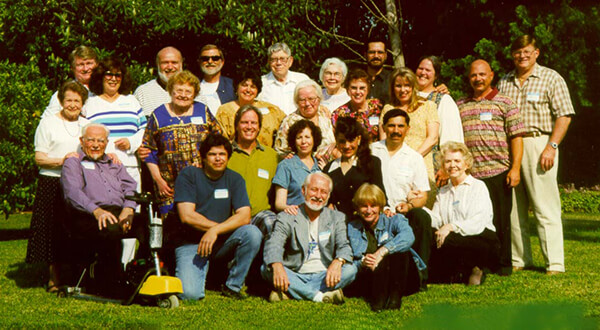
In 1997, at one of Hal and Lucille Kettell's potlucks, I met a devoted reader named Norman Ingram. Norman had recently returned from South America, on an independent mission of placing Urantia Books in libraries and universities there. When he told me he needed funds to go to Africa on a similar mission, I hit upon the idea of collecting everyone’s “how I found the Urantia Book” stories via email, and publishing them in a book that could be sold. My motives were: first, to raise money for Norman; second, to bring under one umbrella all so-called enemies to show that they were spiritual brothers under the skin; third, to provide a historical document of how the Urantia Book had made its way into the world in its first few decades; and fourth, to illustrate that it was unnecessary to have a leading cult or organization in the movement—no IUA, no Fellowship, no Aquarian Concepts Community. The “official” Urantia movement was made up of many individual truth-seekers and small groups of like-minded kingdom workers. This book would paint that picture better than anything else.
Over the next few months I waged an email campaign, netting over two-hundred stories. With funds from the contributors’ preorders, I self-published the first edition of How I Found the Urantia Book, and sold many copies. About $8,000 was raised and handed over to Norman for his African mission, along with extra copies of HIFTUB for him to use as an outreach tool. Working with hundreds of individuals to revise and edit their stories for publication gave me the chance to understand different paths and viewpoints, as well as make many new friends. [The revised edition, with one hundred more stories, was published in 2002.]
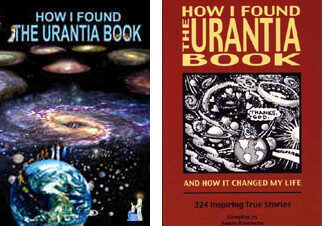
In the late ’90s we began hearing rumblings of a drive for unity within the movement. Past dealings of a secretive nature between movement leaders were now being exposed for all to scrutinize; and with the court cases more and more embarrassing information was coming to light which was conveniently blamed on ousted past leaders, such as Vern Grimsley and Martin Myers. This call for peace, however, was doomed. Each side expected the other to bend and merge under its own peculiar umbrella, in a cookie-cutter unity, not a unity with diversity. They were not ready to relinquish control, accept each other as equals and coexist harmoniously.
As the Foundation and the Brotherhood were busy fighting it out like the Hatfields and the McCoys, another phenomenon began developing on the sidelines. As long as the two majors had put up a united front, the Teaching Mission and like groups had had no chance to thrive. History shows that past factions which operated outside the Foundation/Brotherhood establishment were quickly mowed down. Two examples are the Urantian Research episode in 1971 and the CUBS tragedy of the late 1980s. But once the two main groups began to focus all their resources and energies on each other, the field opened for the true brotherhood of believers to come forward without fear of persecution. The two big organizations were not exactly blind to the existence of these other groups, but in the aura of their self-importance they paid scant attention except, in the Foundation’s case, to denounce them as the “strange and queer isms” the early leaders had been warned about. The following remarks given to early leaders could apply to any Urantia Book group, including the IUA:
Many strange isms and queer groups ... will seek to attach themselves to The URANTIA Book and its far-flung influence. Your most trying experiences will be with such groups who so loudly acclaim their belief in the teachings of the Book and who will so persistently seek to attach themselves to the movement. Great wisdom will be required to guard against the distracting and distorting influence of these multifarious groups and from equally distracting and disturbing individuals, some well intentioned and some sinister, who will strive to become a part of the authentic constituency of the URANTIA movement.
A chilling case of what a Foundation-supported group can evolve into was profiled in the Summer 2002 USUA Messenger. In contrast to a statement on the IUA site that the organization "welcomes people of all faiths, races, and nationalities," the Urantia Association of Florida will not accept members who belong to the Teaching Mission, who mention an interest in A Course in Miracles or who retain a belief in reincarnation. [Read both items here - to come.] Had these IUA people misunderstood the teachings of Jesus? Didn't they realize Team'ers were disseminating the teachings in their own way? Did the IUA consider itself so special that it required the gospel to be preached exclusively under its own narrow banner? And how could they reach out across barriers when association was forbidden with those whose philosophies were different or perhaps in transition?
On a personal note, in 2002 I was hounded out of the Foundation's email discussion lists (urantiat and the forum list) when I announced that my new UB-related study aid, "How Man and the Ape are Related," was available for free on squarecircles.com. The list-op accused me of "peddling my wares" and bringing inappropriate subject matter to the Urantia Book study list. This accusation paved the way for the more fundamentalist posters to denounce me publicly for daring to create a visual aid to help understand the teachings. ("Isn't the book complete as is? Do we really need to add anything to it?") Prior to that, macho members had charged me with unpatriotic behavior for my stance against Bush's war on Iraq, and at an earlier time I withstood Rottweiler-like attacks after I suggested that communication with the dead could be true, that I wanted to leave the door open to the possibility. While these lists are supposedly open to all, only "IUA-approved thinking" is tolerated. Does the Foundation want the intimidating conduct of its supporters to be the first thing new readers encounter on the Internet?
That the IUA was the legally established representative of an epochal revelation designed to build bridges on our already-backward planet was a travesty to me. Its propped-up “teachers and leaders” were so intolerant that only God’s angels could have orchestrated such a scenario to prevent the organization from growing. “Truth-seekers need not apply,” seemed to be their motto. One day I had a comforting insight that it was not God’s will for such an insular group to be given celestial help, and my fears that the fabricated IUA would dominate the movement were quickly dispelled.
As opposed to the IUA, which threatened to disfellowship anyone caught “cheating,” the Fellowship began striving for an image of inclusiveness. When it became apparent that groups were forming and growing “on the outside,” I heard someone on the General Council suggest that the Fellowship offer “franchises” to these groups, under the Fellowship name. For instance, the Teaching Mission would have its own charter as a component of the Fellowship. With membership dropping off steadily, and with no easy way to gain new members, the Fellowship had no choice but to make moves to attract the unaffiliated flock to increase its numbers.
But they did not understand the new “movement.” With the Internet, it was no longer necessary to join an organization to find compatible friends. The TeaM’ers had no intention of organizing themselves into a group with regulations and bylaws. They could stay in touch with one another via computer, hold their own conferences and follow their own rules—or have no rules at all. Rob Crickett and his supporters were free to do the same. The big organizations had made themselves obsolete, and by dividing they had weakened themselves so badly that they were unable to fight the tide of new and vigorous groups. They were now only as good as the work they were doing, or preventing each other from doing.
In 2001 a milestone in the movement occurred when Harry McMullan's Michael Foundation, publisher of Jesus—A New Revelation, won a lawsuit brought against him by Urantia Foundation. [For details of the case, click here; for readers' viewpoints pro and con, click here.] When the jury returned the verdict, the revelation was returned to public domain, and all attempts by Urantia Foundation to regain the copyright have failed.

Take another a look at the great Supreme Urantia Being as it exists in 2003. The three concentric circles are in the center. No group can occupy this sacred spot, and the Foundation must eventually relinquish the universal symbol if it truly seeks peace and harmony. All must divest themselves of ideas of religious sovereignty and learn to coexist peacefully inside the big circle, to work at what they are led to do, and to recognize, support and encourage one another. The only competition should be in the doing of good works. There is room for all and room to grow. All are children of God and a part of the Supreme Being, and all have their roles to play. No longer are the Foundation or the Fellowship greater or lesser than any of the other slices of the pie. "Each according to his works."
With all the talk of Urantians reaching out to Muslims, Buddhists, Hindus, Catholics, Baptists and other religionists, we will not be taken seriously if we don’t first make peace with ourselves, by getting to know and love everyone inside the big circle. This can be accomplished if we stop trying to convert and control one another and instead begin accepting our differences, as in the days of Cymboyton, in Urmia. If Urantians could regard the concentric circles as the symbolic Cymboyton presiding over our movement, we would truly have unity with diversity. And then would we be ready to face the other great religions—and the New Age movement as well—as a fine example of a group that knows how to put higher teachings into practice.
The Urmia religionists lived together in comparative peace and tranquility because they had fully surrendered all their notions of religious sovereignty. Spiritually, they all believed in a sovereign God; socially, full and unchallengeable authority rested in their presiding head—Cymboyton. They well knew what would happen to any teacher who assumed to lord it over his fellow teachers. There can be no lasting religious peace on Urantia until all religious groups freely surrender all their notions of divine favor, chosen people, and religious sovereignty. Only when God the Father becomes supreme will men become religious brothers and live together in religious peace on earth. [1487]
The split was necessary to allow the true brotherhood of believers to emerge and flourish. This could hardly have happened had the two organizations found a way to stay united and strong. The split was a blessing in disguise, a perfect example of how the seraphic planetary government operates behind the scenes to “make things what they ought to be.”

